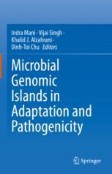Search
Search Results
-
Genomic Islands in Staphylococcus
Staphylococci are Gram-positive bacteria that have successfully evolved from a normal flora with limited threats to potentially life-threatening...
-
Vancomycin heteroresistance among methicillin-resistant clinical isolates S. haemolyticus, S. hominis, S. simulans, and S. warneri
Besides being an essential part of the skin microbiome, coagulase-negative staphylococci are the etiological factors of serious infections. The aim...

-
Interference and co-existence of staphylococci and Cutibacterium acnes within the healthy human skin microbiome
Human skin is populated by trillions of microbes collectively called the skin microbiome. Staphylococcus epidermidis and Cutibacterium acnes are...

-
Incidence of uterine infections, major bacteria and antimicrobial resistance in postpartum dairy cows in southern Ethiopia
BackgroundUterine infections, primarily caused by bacterial pathogens, pose a significant problem for dairy farmers worldwide, leading to poor...
-
Knema retusa is antibacterial and antibiofilm against antibiotic resistant Staphylococcus aureus and S. haemolyticus isolated in bovine mastitis
This study aimed to assess antibacterial activity of Knema retusa wood extract (KRe) against antibiotic resistant staphylococci which are causative...

-
Biofilm Changes of Clinically Isolated Coagulase Negative Staphylococci
Coagulase Negative Staphylococci (CoNS) are remarkable for the heterogeneity in the chemical composition and structural architecture of its biofilm....

-
Bullet-related bacterial wound infections among injured personnel at emergency site hospitals in Bahir Dar: prevalence, antimicrobial susceptibility and associated factors
BackgroundBullet-related bacterial wound infection can be caused by high-velocity bullets and shrapnel injuries. In Ethiopia, significant injuries...

-
Antimicrobial activity of ceftobiprole and comparator agents when tested against gram-positive and -negative organisms collected across China (2016–2018)
BackgroundCeftobiprole is a fifth-generation cephalosporin which has been reported to have broad antibacterial spectrum when tested against bacteria...
-
Mucoid Staphylococcus haemolyticus: an unheeded multidrug-resistant pathogen
Coagulase-negative Staphylococci (CoNS) are among the most abundant members of human skin microbiome. CoNS have lately been recognized as substantial...

-
Resistance profile and biofilm production capacity of Staphylococcus spp. beef slaughterhouse isolates and their sensitivity to Rosmarinus officinalis essential oil
Microorganisms can interfere with meat quality, being a public health problem. The aim of this study was to characterize the antimicrobial...
-
Characterization of virulence factors and antimicrobial resistance in Staphylococcus spp. isolated from clinical samples
The virulence factors, antibiotic resistance patterns, and the associated genetic elements have been investigated in Staphylococcus species. A total...

-
Milk supply chain as a reservoir of antimicrobial-resistant Staphylococcus species
Milk is a source of essential nutrients, but food safety across the milk supply chain has emerged as an integral part of food trade. Of the several...

-
Fecal coagulase-negative staphylococci from horses, their species variability, and biofilm formation
The intestinal microbiota has enormous impact on the health and performance of horses. Staphylococci belong in the phylum Firmicutes, and their...
-
High level of persister frequency in clinical staphylococcal isolates
BackgroundStaphylococcus aureus is a notorious human pathogen that causes often lethal systemic conditions that are mostly medical device associated...

-
Antimicrobial activity of organic acids against canine skin bacteria
Canine skin is often a source of bacterial strains that are characterized by the presence of important virulence factors and a high antimicrobial...
-
Susceptibility of caprine mastitis pathogens to tildipirosin, gamithromycin, oxytetracycline, and danofloxacin: effect of serum on the in vitro potency of current macrolides
Mastitis is a significant disease in dairy ruminants, causing economic losses to the livestock industry and severe risks to public health. Antibiotic...

-
Bacterial profile of high-touch surfaces, leftover drugs and antiseptics together with their antimicrobial susceptibility patterns at University of Gondar Comprehensive Specialized Hospital, Northwest Ethiopia
BackgroundThe hospital environment serves as a source of nosocomial infections, which pose a major therapeutic challenge. Although many bacteria...

-
Staphylococcins: an update on antimicrobial peptides produced by staphylococci and their diverse potential applications
AbstractStaphylococcins are antimicrobial peptides or proteins produced by staphylococci. They can be separated into different classes, depending on...

-
The Efficacy of Bacteriocins Against Biofilm-Producing Bacteria Causing Bovine Clinical Mastitis in Dairy Farms: A New Strategy
Using an alternative bio-product is one of the most promising ways to control bovine mastitis and avoid new intra-mammary infections. The aims of...

-
Effect of preservation fluid contamination and associated possible donor-derived infections on early postoperative prognosis in kidney transplant recipients
BackgroundThe study aims to analyze the epidemiology of preservation fluid (PF) contamination and investigate the impact of PF contamination and...
